Carthaginian Art › Etruscan Pottery » Ancient origins
Articles and Definitions › Contents
- Carthaginian Art › Ancient History
- Etruscan Pottery › Antique Origins
Ancient civilizations › Historical and archaeological sites
Carthaginian Art › Ancient History
Definition and Origins
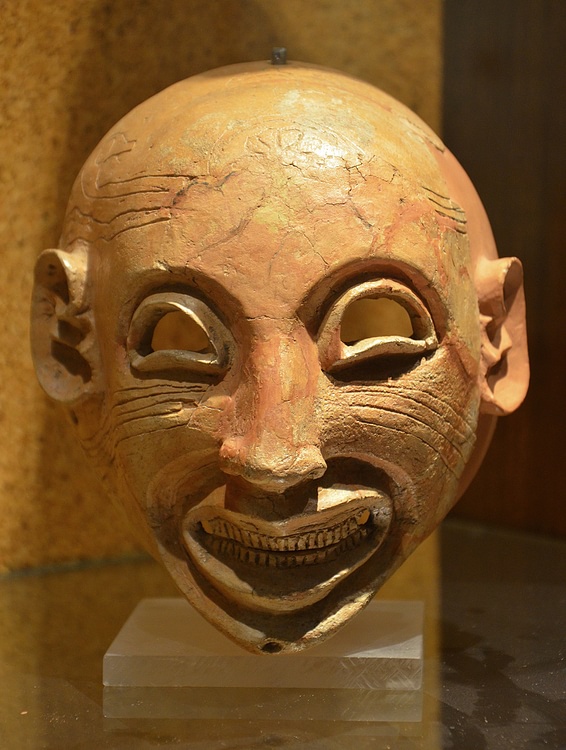
The art of the Carthaginians was an eclectic mix of influences and styles, which included Egyptian motifs, Greek fashion, Phoenician gods, and Etruscan patterns. Precious metals, ivory, glass, terracotta, and stone were transformed into highly decorative objects ranging from everyday utensils to purely ornamental pieces. Just as the Carthaginians imported and exported all manner of trade goods, so too their art reflected their vast network of contacts across the ancient Mediterranean but they would eventually produce their own distinctive art which uniquely blended elements from other cultures. The distinctive qualities of Punic art can be best seen in their stelae, jewellery, sculpture, and masks.
Surviving examples of Carthaginian art are sadly few in comparison to contemporary cultures, and they are further limited in scope by the fact that the majority of artefacts come from a burial context and so are predominantly small in scale and of a religious nature. Secular art and objects produced exclusively for their aesthetic value are rare indeed. Nevertheless, enough examples survive of jewellery, figurines, ceramics, and stonework to hint that the Carthaginians were not as artistically impoverished as earlier historians saw fit to claim.
INFLUENCES
Carthage was founded in the 9th century BCE by colonists from the Phoenician city of Tyre. This fact and the city's continued close ties with the mother country meant that art was heavily influenced by that of Phoenicia, at least in its formative years.Just as Phoenicia was itself a melting pot of diverse cultures, its wealth based as it was on maritime trade, so too Carthage would become a cosmopolitan city with visitors, residents, and artists from across the ancient Mediterranean. Egyptian artwas particularly influential and many motifs are seen in Carthaginian art such as the goat with head looking backwards beneath a sacred tree or rigid standing female figures. Near Eastern art was another strong influence, seen especially in figurines of the god Melqart /Baal. The influence of Etruscan artists is seen especially in Carthaginian pottery decoration from the 4th century BCE.
CARTHAGINIAN ARTISTS REPEATED, COMBINED, & EVOLVED MOTIFS FROM EGYPTIAN, NEAR EASTERN, & GREEK ART TO PRODUCE AN ECLECTIC MIX OF STYLES.
Above all, though, Carthage's art took inspiration from the Greek world from the 5th century BCE onwards. Not only were the Carthaginians appreciative collectors of Greek art, taking fine art as booty from their campaigns in Sicily, but they also produced imitative art. There was a large Greek community at Carthage, and many of these must have worked as skilled craftsmen in the workshops of the city. In turn, they would have taught local artists or the next generation. We know of at least one artist whose father was a Greek immigrant but who signed his work as 'Boethus the Carthaginian' and who became so appreciated that his work was dedicated at Olympia.
There is a general problem of identifying the exact origin of many art pieces which is exacerbated by the Punic habit of copying foreign motifs and styles. Traditionally, historians had favoured the view that, at least in general, finer pieces were imported and more rustic art was locally made. This unflattering view is steadily being revised following the discovery of large workshop areas in the city suggesting a healthy export trade and by new archaeological discoveries so that the position that all of the fine art was imported is becoming increasingly untenable.
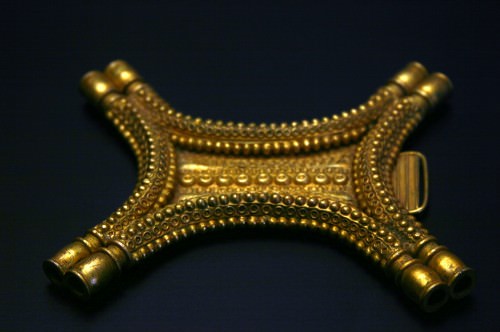
Phoenician-Punic Gold Pectoral
MATERIALS
The materials used by Carthaginian artists were many. Coloured glass and glass paste were used to make jewellery beads and small perfume amphorae. Ivory was carved to make decorative plaques which could be hung on walls or added to furniture. Sometimes semi-precious stones, glass or faience were added to these plaques for extra sparkle. The same material was carved to make such everyday items as knife and mirror handles, combs, small boxes, and intaglios. Terracotta was used to make figurines of deities, masks, incense burners, and simple cups, bowls, and trefoil-jugs. It was also used to make circular decorative plaques. Gold was employed for jewellery and could be hammered, cast, granulated, repoussé, or applied as gold leaf. Surviving gold pendants take the form of fruit, small busts, and objects from nature such as a chrysalis.Stone, in rare cases also marble, was carved to produce tomb stelae, ossuaries, and small temples placed above graves.Bronze was employed for figurines, and especially common were hatchet razors. Left with the deceased in tombs for use in the after-life, they often have a swan or ibis-headed handle and were beautifully incised with images of gods from the Phoenician, Greek, or Egyptian pantheon.
COMMON MEDIA & THEMES
Figurines & Masks
Figurines of a female goddess, probably considered a protectress, are a relatively common dedication in early tombs and graves. They were also offered either as a request for or in thanks for healing. The figures are simply rendered with a flat-topped head and cylinder body. Figurines of the god Melqart sitting on a throne, with his right hand raised in blessing, and typical conical hat were produced in large numbers, too.
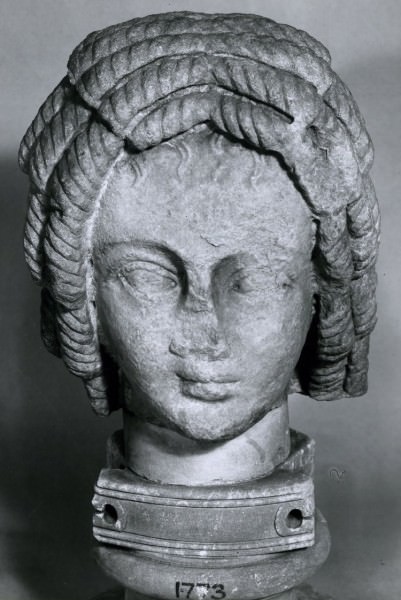
Carthaginian Portrait Bust
From the 4th century BCE many figurines display a Greek influence, especially in their clothing such as the chiton and peplosrobes, and himation cloak. Although the Carthaginians applied many conventions of Greek art to their own figure sculpture, it is striking that one element they did not adopt was the nude. Punic figures are always clothed. Female figures playing tambourines have been excavated at various Carthaginian sites, and some of these figures blend Greek clothing with Egyptian winged-portrayals of Isis wearing a typical Egyptian, wide collar. As with Greek sculpture, these human figures were originally brightly painted.
Cavalry riders appear in several mediums, notably on a 6th century BCE terracotta circular plaque from Douimes. The warrior wears a crested helmet, carries a circular shield, and has his dog running alongside his horse. Another terracotta product was receptacles in the shapes of animals, ducks, and cow's heads.
Grinning masks, made from painted, incised, and stamped terracotta, were given lively grimacing expressions and deep wrinkle lines. With empty eyes and open mouths, they were left in tombs in order to ward off evil spirits or hung on walls of houses for the same purpose. They were certainly not worn as they are less than life-size. These masks were produced in large numbers but are all unique. A second type was masks of smiling female faces ( protomai ), but these were not grotesque like the male versions. Both types could be made using moulds.
Jewellery
Necklaces composed of individual glass beads shaped into male heads are a typical item of Carthaginian jewellery. Each face has curly hair, a beard, and the large staring eyes so often seen in the faces of Punic art. Beads were also made from gold, silver, and pearls. Pendants, earrings, bracelets, nose-rings, ankle-rings, and diadems were all worn by the Carthaginians who could afford them. As with Egyptian jewellery, lions, falcons, gods, lotus blossoms, and palmettes were typical forms of decoration. Many vitreous paste beads carry eye motifs. Carthaginians, also like the Egyptians, carried tiny papyrus scrolls on their person which had written on them spells and formulas against all manner of potential disasters. These scrolls were kept in precious metal boxes incised with the motifs just mentioned.
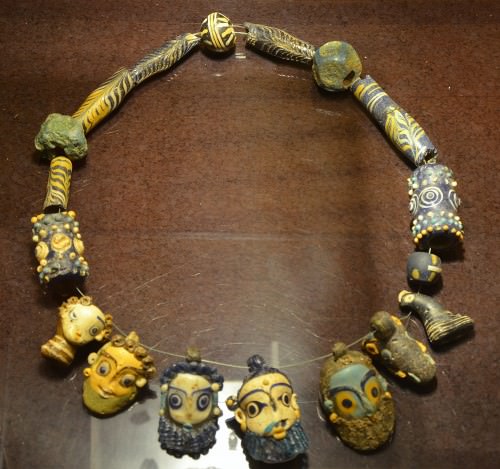
Carthaginian Necklace
Amulets of glass paste covered by enamel and carved seals of gold and semi-precious stones (eg agate and jasper) often depicted Egyptian deities such as Bes, Ptah, and Isis, or took the form of familiar Egyptian symbols like the ujat eye, crown of Upper Egypt, and lotus flower. Scarabs were produced in large numbers at Carthage too and were carved from jasper, cornelian, lapis lazuli, agate, rock crystal, basalt, and glass paste. They were worn as protection against all kinds of mishaps, as symbols of social rank and citizenship, or as a means to increase the healthiness of particular parts of the body. Intaglios are another area of Greek influence. These incised ivory jewellery pieces often depict scenes from Greek mythology, especially involving Dionysos and Demeter.
Decorative Objects
One of the most common Punic decorative objects and a popular export was ostrich eggs. These usually have their tops cut off, but some are complete and were drained through a single small hole in the base. They were decorated with geometric forms, palms, and lotus blossoms using red paint. Symbolising regeneration or the cosmic egg of creation they were a common votive offering in tombs. Another use was to paint fragments of the shells with faces to create miniature masks.
Glass was used to produce small two-handled vessels used for storing perfumes. These had been long-produced in Phoenicia and Egypt, but the Carthaginian type is distinctive for its very dark blue glass decorated with yellow, white, or turquoise stripes achieved by adding thin trails of hot glass over the inner main shell.
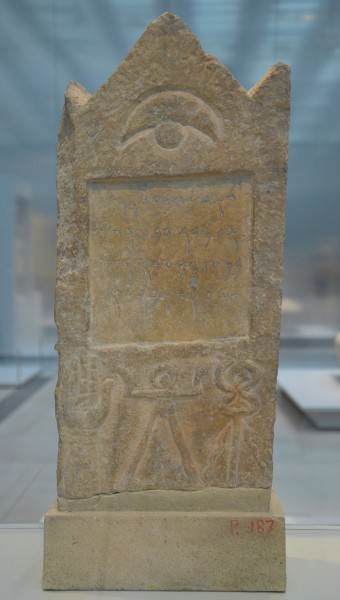
Punic Stele with Goddess Tanit
Stelae
Sandstone and limestone stelae measuring up to 1.5 metres in height are the most common medium of Punic art which survive. They were carved for placement above tombs, especially in the tophet, where many carry a lozenge-shape, hexagon, or bottle-shaped decoration, or the symbol of Tanit. The earliest type (7th-6th century BCE) was a miniature architectural model of a temple or altar shaped like a throne. These are known as cippi (sing. cippus ) and they often copied the facades of Egyptian temples and were topped by a solar disk and/or a crescent moon. Later types (from the 5th century BCE) have a triangular top and took inspiration from Greek architecture with Ionic columns and winged sphinxes used as common decorative features. An outstanding example of the eclectic mix of Carthaginian art is the stele set above the tomb of Hadrumetum, c. 250 BCE in the tophet of Carthage, with its single Ionic column topped by a sphinx above which are Egyptian-like palm fronds.
From the 3rd century BCE, portraiture was sometimes attempted and many stelae have animal figures, a hand motif, and a male figure seated on one bent leg. The exact significance of these and the earlier geometric motifs is still debated amongst historians. Many stelae show traces of stucco and paint and their production was in no way interrupted by the Romandestruction of Carthage in the mid-2nd century BCE.
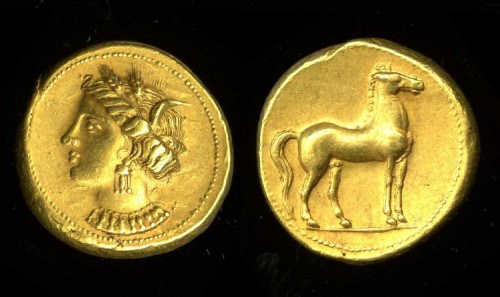
Carthaginian Electrum Coin
Sarcophagi
Sometimes, instead of a stele, tombs had a carved stone ossuary to preserve the bones of the deceased. Of Near East origin, these could present a full-length representation of the deceased on the lid and reproduce a life-like portrait of the face. One such example is the 4th-3rd century BCE ossuary of a priest from the Santa Monica cemetery at Borj-el-Jedid. Full-size Punic sarcophagi generally mixed Egyptian forms with a Hellenistic portraiture of the occupant on the lid. The earliest are the most Egyptian, and the person is represented in a flat view, and then, as Carthage saw more Greek influence in art in general, the figures become more three-dimensional.
Coinage
Punic coins were minted in Sicily from the 5th century BCE and at Carthage itself from the 4th century BCE. The most common designs include a horse's head, a full horse with Nike above, a single palm tree, Melqart with a club like Hercules, a war elephant, the prow of a warship, a lion in front of a palm tree, and head of a female goddess (especially Tanit, less often Demeter and Kore) which were all stamped on both sides of coins of silver, gold, electrum, and bronze.
Etruscan Pottery › Antique Origins
Definition and Origins
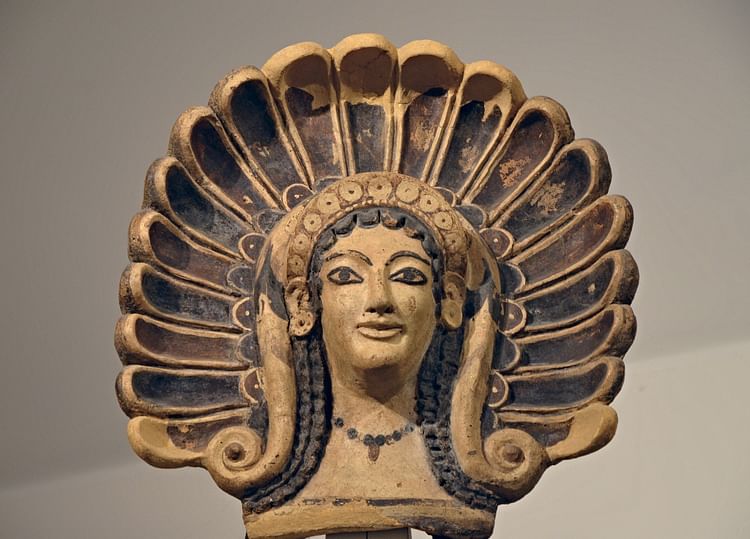
Etruscan pottery, produced over five centuries, was nothing if not varied. Indigenous wares such as the glossy black bucchero were made alongside red- and black-figure pottery imitating, yet modifying those produced in the Greek world.Geometric, floral, figure, and narrative decorations were appreciated and adapted from the Near East and Ionia, with even foreign potters and artists themselves settling in the cities of Etruria, such was the demand from the Etruscans for fine pottery for everyday use, at special banquets, and as offerings to their gods and dead. Pottery was also the material of choice for figure sculpture, best seen on the lids of large funerary urns, and as decoration for buildings in the form of statues and decorative plaques. Besides what they have left us of their own work, the Etruscans, great collectors of fine pottery that they were, have secured for posterity some of the finest Greek vases ever made and which now star in the collections of museums worldwide.
VILLANOVAN POTTERY
The Villanovan culture was a precursor to the more developed Etruscan civilization during the Iron Age in central Italy from c. 1000 to c. 750 BCE. In this period pottery was made by hand, not on the wheel, and used clay containing impurities of mica or stone which was fired at a low temperature producing relatively primitive wares. This type of pottery, known as impasto, was used to make bowls, storage jars, cooking pots, cups, and braziers. By the end of the 8th century BCE, potters had managed to improve the quality of impasto through long practice and refinement of technique.
Villanovan cemeteries contain burials of cremated remains in urns which are biconical (two vases with one smaller one acting as a lid for the other) and often carry simple incised decoration of geometric patterns, whirls, and swastikas, or even simple human 'stick' figures. Some urns have metal strips applied as decoration using lead or tin. One rarer type of urn, instead of a ceramic lid, has a bronze helmet on top with an impressive angular crest and embossed decoration.

Etruscan Model House
Another common form where terracotta was used was the production of small models of houses, made to contain the ashes of the deceased. Perhaps imitating real architecture, these have decoration on the exterior walls of geometric patterns and an aperture above the door for releasing smoke. They also have roof decorations, probably imitating the terracotta additions which became so typical in later Etruscan architecture.
RED ON WHITE WARES
This type of pottery, originating from Phoenicia, was produced in Etruria from the end of the 8th century BCE and into the 7th century BCE, particularly at Cerveteri and Veii. The red-coloured vessels were often covered with a white slip and then decorated with red geometric or floral designs. Alternatively, white was used to create designs on the unpainted red background. Large storage vases with small handled lids are common of this type and then kraters which also have scenes such as sea battles and marching warriors.
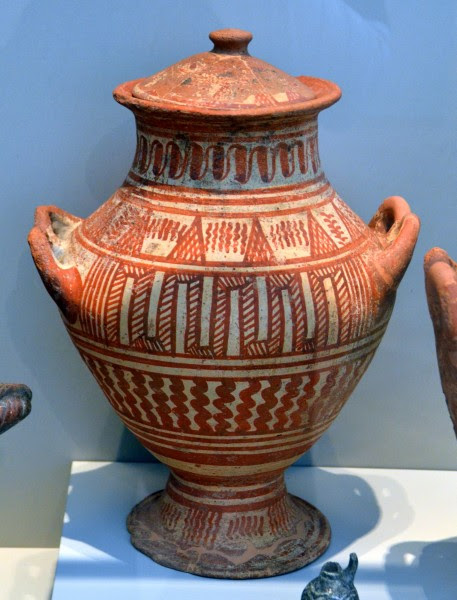
Etruscan Red on White Pottery Vessel
BUCCHERO WARES
Largely replacing impasto wares from the 7th century BCE, bucchero was used for everyday purposes and as funerary and votive objects. It was preceded by an intermediary type known as buccheroid impasto. Turned on the wheel, this new type of pottery had a more even firing and, using the process of oxidation in the kiln, gave a consistent and distinctive glossy dark grey to black finish (the clay's red ferric oxide being turned into black ferrous oxide).
THE ETRUSCANS WERE MEDITERRANEAN-WIDE TRADERS & THEIR POTTERY WAS THUS EXPORTED BEYOND ITALY TO PLACES FAR AFIELD AS IBERIA, THE LEVANT & THE BLACK SEA AREA.
The earliest known examples come from Cerveteri and date to c. 675 BCE. Bucchero was produced in many Etruscancentres (notably Cerveteri, Tarquinia, Veii, and Vulci ) and has become a hallmark of Etruscan presence at archaeological sites in central and northern Italy. The Etruscans were Mediterranean-wide traders, too, and bucchero was thus exported beyond Italy to places far afield as Iberia, the Levant, and the Black Sea area.
Common shapes include bowls, single- and two-handled cups, amphorae, chalices, and jugs. More elaborate pieces have the addition of three-dimensional figures of both humans and animals. Bucchero votive and funerary offerings typically take the form of figurines and service trays ( focolare ) complete with bowls, plates, cups, and utensils. Decoration resembles that of metal vessels with added pieces and carving before firing to resemble embossed work. Some bucchero vases were covered in gold or silver leaf, sometimes also a thin layer of tin. Vessels are most often plain but can be decorated with simple lines, spirals, and dotted fans incised onto the surface. Red ochre was sometimes painted into these incisions. Patterns and simply rendered scenes from mythology could be applied to the pot before firing using a stamp.
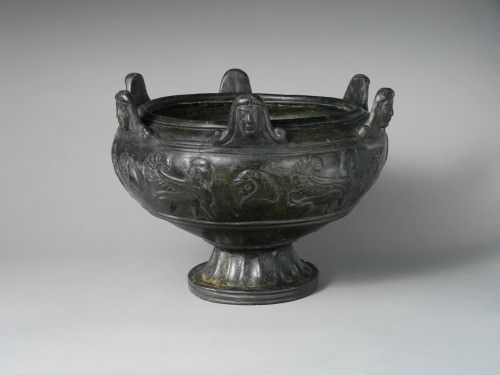
Bucchero Krater
Curiously, bucchero wares display the reverse trend of refinement seen in many other pottery type evolutions. The early period wares are finer with much thinner walls and more carefully made; these are known as sottile or fine (675-626 BCE). There is then an intermediary stage known as transizionale or transitional (625-575 BCE) before a final phase when wares are described as pesante or heavy (575-480 BCE). Finer wares are generally associated with the southern Etruscan cities and the heavier type with the northern. By the early 5th century BCE, bucchero was replaced by finer Etruscan pottery such as black- and red-figure wares.
ETRUSCO-GREEK WARES
Between 670 and 600 BCE, many pottery vessels were imported from Corinth especially, Attica, Ionia, and the Near East.Popular imports from Phoenicia were the beak-spouted jug and the 'pilgrim flask,' a round flat bottle with geometric decoration.These imported goods, and sometimes the immigration of the artists themselves, inspired Etruscan artists to produce their own versions and to copy the new style of decoration in their own work. Plants, animal and human figures now replaced the rather austere geometric designs that had hitherto dominated. Wares were produced in such large quantities that art historians have been able to identify several distinct Etruscan pottery painters based on style and subjects. One such artist is the Micali Painter of Vulci who is credited with over 200 surviving vases. Scenes from Greek mythology are typical but with local additions and inventions. The large Caeretan hydria, a two-handled vase for holding water, was a speciality of Cerveteri.
In the 4th and 3rd century BCE there developed a trend of using column -krater vessels as funerary urns and these were often painted with two large heads facing each other, one male and one female. Although not portraits as such, they are more natural than similar depictions on Greek pottery. An inventive method to cheaply imitate metal wares was developed whereby pottery vessels were dipped into a basin of tin to give them a thin shiny coating which resembled silver, hence their name, ceramica argentata. Finally, and unique to the Faliscan region, mould-made standing heads of a goddess (perhaps Demeter ) were manufactured and deposited as guardians in tombs.
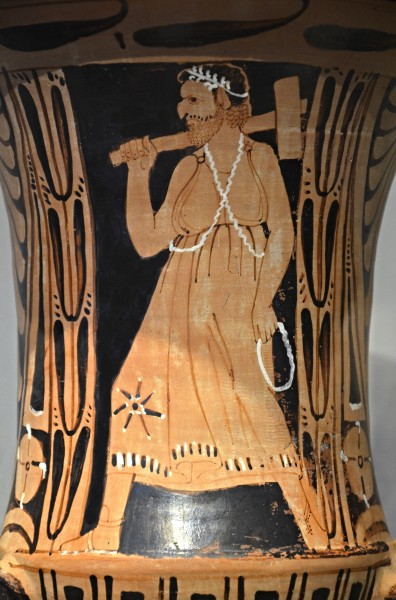
Etruscan Red-Figure Krater with Charun
Despite this varied home production, though, original Greek vases continued to be highly esteemed and frequently deposited in Etruscan tombs, one of the best sources of these wares outside Greece. As an example, the appropriately named Tomb of the Grecian Vases at Cerveteri had over 150 red- and black-figure pottery vessels from Attica deposited inside over several generations from 550 BCE onwards.
TERRACOTTA ROOF DECORATIONS
One unusual field of pottery which became a particular Etruscan speciality was the creation of terracotta roof decorations. The idea went back to the Villanovan culture where the apex roofs of simple huts received such decoration. The Etruscans went one step further than similar decorations on Greek buildings and produced life-size figure sculpture to decorate the roofs of their temples. Private buildings also had terracotta decoration in the form of plants, palms, and figurines. The most impressive survivor from this field is the striding figure of Apollo from the c. 510 BCE Portonaccio Temple at Veii. The interior of this temple was further decorated with terracotta panels depicting scenes from mythology.
Terracotta panels were also used on the outside of buildings, too, usually on gable ends, and the format is best seen in 7th- and 6th-century BCE examples from Acquarossa. They show scenes of a dinner or drinking party with guests lounging on benches; musicians and dancers, including one acrobatically doing a cartwheel; and a procession of warriors carrying spears and shields accompanied by charioteers. The panels are currently on display in the National Etruscan Museum at Viterbo.
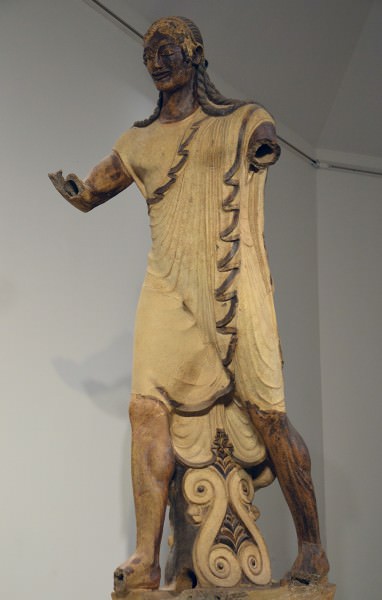
Apollo of Veii
SARCOPHAGI & FUNERARY URNS
The Etruscans buried the cremated remains of the dead in funerary urns made of terracotta. During the 6th century BCE, there was also a trend of burying the body in decorative sarcophagi. Both types could feature a sculpted figure of the deceased on the lid and, in the case of sarcophagi, sometimes a couple. The most famous example of this latter type is the Sarcophagus of the Married Couple from Cerveteri, now in the Villa Giulia in Rome. The two figures recline on a couch or bed with the husband's right arm around the shoulders of his wife. Originally they would have held objects such as perfume bottles or eggs, symbols of regeneration.
Chiusi offers another interesting use of pottery. Early tombs there contained large terracotta vessels inside which were placed 'Canopic' jars containing the cremated remains of the deceased. The jars, typically half a metre in height, are made to resemble human figures, sometimes with a bronze mask attached, dressed in clothing, belts, and jewellery, and seated on miniature thrones of stone, bronze, or terracotta.
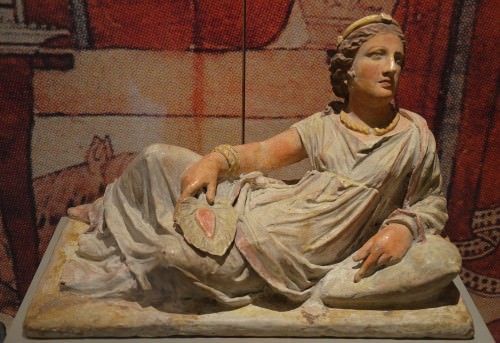
Etruscan Funerary Portrait
In the Hellenistic Period the funerary arts really took off, and figures, although rendered in similar poses to the 6th-century BCE sarcophagi versions, become less idealised and more realistic portrayals of the dead. They usually portray only one individual and were originally painted in bright colours. The sides of the lower box part are often decorated with relief sculpture depicting scenes from mythology or architectural motifs, for example, triglyphs and rosettes. The Sarcophagus of Seianti Thanunia Tlesnasa from Chiusi is an excellent example and is now in the British Museum in London.
LICENSE:
Article based on information obtained from these sources:with permission from the Website Ancient History Encyclopedia
Content is available under License Creative Commons: Attribution-NonCommercial-ShareAlike 3.0 Unported. CC-BY-NC-SA License